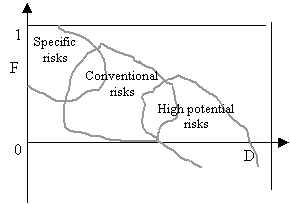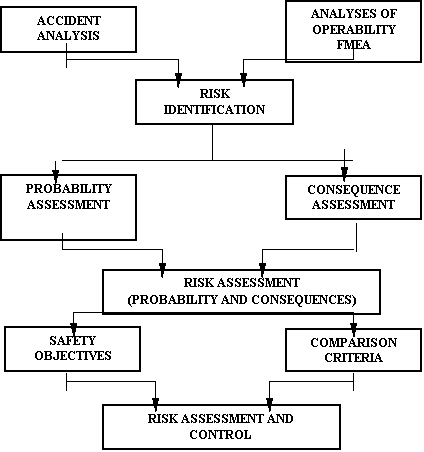|
|
|
2. RISK
ANALYSIS Two factors have given
rise to new risk analysis studies of industrial activity: one
is the emphasis on increasing industrial production with the
aid of new machinery and ever greater innovations in industrial
process and the other is an increase in public awareness of
the need to safeguard workers’ health. In the maritime sector
in particular several incidents have occurred in the last twenty
years which have brought the phenomenon of work injuries to
the attention of the public, along with all the risk aspects
of work in shipyards. This is the background
for this study, which investigates risks in shipbuilding and
in the production of fibreglass and composite materials vessels
in general. Before seeking to identify
and evaluate risks it is necessary to provide some basic definitions. “Risk” (R) is defined
as the product of the expected frequency (F) of a certain undesired
event multiplied by the seriousness of the damage (D) that the
event may cause: R = F x D This definition was
first introduced at the end of the seventies in analyses of
reliability and safety. Although it is not universally accepted,
it is certainly a good attempt to describe in analytical terms
exactly what is meant by the concept of risk. The risks connected
with any type of work can be classified as follows:
·
Conventional risks. These are connected to the work
activity and the equipment and plant present in all industrial
sectors (falls from platforms or stairs, crushing under heavy
objects, electric shocks, moving machine parts). These are relatively
frequent and on average affect one or two people. (Figure 4).
·
Specific risks. These relate to the use of chemical
substances and to exposure to physical agents such as noise
or extreme temperatures. By their nature these risks can, in
the short or long term, harm people, things and the environment.
They are continual or very frequent events which can cause little
damage in the short term, but can have long term negative effects
on subjects exposed over a period of time.
·
High potential risks. These arise out of unusual events,
and can cause explosions or emissions of toxic or inflammable
products in such large quantities as to effect large areas on-
and off-site. They are very rare events with particularly serious
consequences.
Figure 4 - Types of risk and their frequency
2.1.3 Identifying and evaluating risk Many different activities
are involved in analysing risk and figure 5 shows how they interrelate.
·
Identification of event or potential event or exposure
to harmful substances
·
Estimate of the frequency of occurrence of the event;
·
Estimate of the damage caused by the event
·
Evaluation of risk on the basis of estimated frequency
and damage
·
Evaluation of the acceptability of the risk on the
basis of technical, health, environmental and social criteria.
Figure 5 - Activities involved in risk analysis
2.1.3.1
Identifying and evaluating risk Identifying possible
incidents and conditions of work which may give rise to exposure
to danger is carried out through analysis of the activities
mentioned in Figures 1, 2 and 3 for different types of work
activity. This results in the identification of the type of
risk present in each individual activity. A matrix of activity/type
of risk can then be produced. An example is shown in Table 1.
Table 1 - Activity/type of risk matrix The Tuscan Regional
Authority has carried out a study of this type, although without
using the activity/risk matrix. The study was presented to the
National Convention at Viareggio on 30/31 October 1989. The
results were also published by ISPESL in the “Fogli d’informazione
ISPESL. Cantieri navali” Year IV, 2nd supplement to the 1st
issue 1993. Frequency is estimated
approximately according to a qualitative scale which is arbitrarily
translated into numeric sequence. Suggested scale:
Damage is estimated
approximately according to a qualitative scale which is arbitrarily
translated into numeric sequence. Suggested scale:
More analytical estimates can be made for certain
types of damage. Here too, it is suggested that whatever the
estimation method used, all the results obtained should be presented
on a single scale, such as that above. The two scales suggested
for numerically evaluating the frequency F and the damage D,
although being arbitrary, provide an estimate of frequency based
on experience, calculation and data banks. They similarly provide
an estimate of different types of damage, thereby allowing an
evaluation of risk in numeric terms for all activities (or events)
on an arbitrary scale. This means that an evaluation
matrix can be drawn up (Table
2).
2.1.4. Risk analysis in this study A general method for
risk evaluation in semi-quantitive terms will be suggested in
this study, but as the focus is on health and safety for shipyard
workers the emphasis will be on identifying specific risks.
|
|||||||||||||||||||||||||||||||||||||||||||||||||||||||||||||||||||||||||||||||||||||||||||||||||||||||||||||||||||||||||||||||||||||||||||||||

